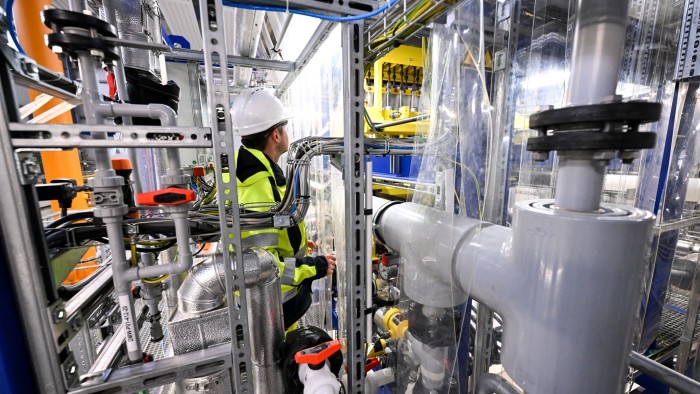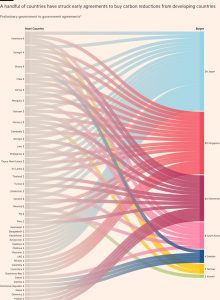How to put Europe’s savings to work

Unlock the Editor’s Digest for free
Roula Khalaf, Editor of the FT, selects her favourite stories in this weekly newsletter.
This article is an on-site version of Martin Sandbu’s Free Lunch newsletter. Premium subscribers can sign up here to get the newsletter delivered every Thursday. Standard subscribers can upgrade to Premium here, or explore all FT newsletters
In my latest FT column, I pointed out that European politicians cannot in good faith argue that resources are lacking when the EU exports hundreds of billions of euros in unspent savings every year (see chart below). As both Enrico Letta’s and Mario Draghi’s reports on how to improve the EU’s single market and raise its productivity point out, these capital exports — the flip side of the large trade surplus — mean that the EU economy is financing investments abroad even as it faces yawning investment shortfalls at home.
But as some readers have pointed out, what are the sort of policies that could redeploy these large current account surpluses to fund greater investments abroad?
There are many facts about national income accounting that are far from obvious until you have spent some time wrapping your head around them. One of them is that your economy’s export surplus (roughly; you need to add in net income from abroad) is the same as the amount by which your domestic investments fall short of your savings. That is an arithmetical truth, which has an immediate economic implication and a less immediate but important implication for political economy.
Economically, this implies that it should be physically possible for you to build productive capital faster — ie invest more — without having to sacrifice anyone’s consumption of goods and services. With luck and good judgment, that just could increase the growth rate of your national income.
In terms of political economy, it offers an answer to the current political conundrum in the EU, where virtually everyone agrees with Draghi’s recommendation for much more investment — not necessarily public — but agonises over how to pay for it. The agony is understandable enough; every politician knows the political cost of taking resources away from anyone. So it should be appealing to redirect savings abroad into the bloc instead, which, in theory, allows you to raise investment without taking away any resources currently consumed domestically. And the numbers are big: in the past four quarters of available data, the EU current account surplus topped €500bn.
It’s not a matter of discouraging exports per se. A smaller external surplus could mean shifting some resources currently producing goods and services for export towards domestic uses, but it should also involve imports going up, to substitute some domestic resources being reallocated towards investment rather than consumption.
But how would you do this? The external surplus is not a policy variable that you can turn up and down. It is the outcome of myriad decisions over trade, consumption, investment, borrowing and how to place private savings. Which means you could think of policies to alter any of those (and more) to work towards the desired outcome of more European savings going to fund productive investment in Europe. Here is a tentative list of what I can think of.
Financial policy. One could try to directly discourage capital exports. This could be done by boosting domestic borrowing and fundraising for investment. The government can borrow more — not necessarily to increase deficits but, for example, to seed an investment fund that then places capital in the private sector. Or tax rates can be recalibrated in budget-neutral ways to reward capital raising for investment and penalise saving. This should redirect savings towards domestic investment and raise imports as well as domestic activity. You could even go into financial repression territory and directly tax savings held abroad more heavily than savings kept inside the EU.
Fiscal and monetary policy. One could “run the economy hot” by boosting aggregate demand. This would reduce the external balance in two ways: by increasing imports, and by increasing domestic investment incentives through more optimistic expectations for sales of the output of companies that decide to expand. Those shifts by themselves would pull resources towards the EU by reducing the investments-savings gap. Whether it does this through more investment or less saving (ie more consumption) depends on the details of the policy package.
Regulatory policy. This is where the well-rehearsed capital markets and banking union agendas fit in. The (no doubt correct) premise of both is that cross-border frictions remain to bank lending and securities investment despite the EU’s soi-disant single market. It stands to reason that some investment flows would be redirected back into the EU if these frictions were removed. These agendas are important. (Klarna is the latest example of how European savings somehow cannot find their way to funding homegrown companies that want to go public in a big way.)
But they are not the only regulatory measures that could affect the external surplus. Others include steps to encourage invoicing in euros for trade with non-EU countries, which would tilt some of the reasons for accumulating savings in US dollars rather than euros. (For maximum effect, combine that with making EU common borrowing permanent, to ensure financial markets have a large supply of euro-denominated benchmark assets.)
Sectoral policy. This is really a combination of the above, but with a special targeting of the sector that drives the export of capital. As the chart below shows, the Eurozone’s external surplus has a counterpart in the savings surplus of the domestic private sector, since the public sector is in deficit. It is understandable that the household sector is a net saver: people age, and families want to accumulate wealth.
But why should we want the corporate sector to run surpluses, ie to invest less than it saves? It is private non-financial corporations, after all, that in a capitalist economy make the on-the-ground choices of where to build productive capital — and if they do this well, raise funds from other sectors to do so. In a dynamic economy, in other words, we would hope for the corporate sector to be in a permanent modest deficit, because it would be constantly drawing in funds, investing them and growing so that its liabilities remain easily serviced.
Successfully redeploying the current external surpluses should, therefore, mean turning Europe’s corporate sector from a macroeconomic saver into a macroeconomic investor-borrower (take “borrower” in a broad sense — equity funding would be better than debt funding). One can imagine reforms to tax policy (to penalise retained and redistributed earnings, and reward actual investments with “super-deductions”, for example) and regulatory policy (to change accounting and capital adequacy rules for banks, for example, to encourage lending to companies expanding investment). But crowding in private productive investment with outright fiscal spending or monetary tools (such as targeted lower rates for bank lending for new capital) has a role too.
All have I done above is to set out some tentative directions in which to look for technical policy solutions that will do the job. Those closer to the ground of policy formulation will have more detailed and no doubt different and better ideas. But there is the politics to consider as well. Two dimensions are particularly important.
One is the level at which the technical policy tools are handled; many of the options listed above are really in the hands of national governments rather than the EU institutions. But the EU can help by pursuing bloc-wide legislation that encourages national governments to act.
The other dimension is Europe’s relations with Donald Trump’s America. Despite his proclaimed dislike of bilateral trade deficits, Trump may not welcome policies that penalise EU capital flows going into the US. On the other hand, an overall programme of policies whose stated goal is to reduce the EU surplus is something that should be possible to sell to the Trump White House. Given that this can be in the EU’s interest too, there is no time to waste.
Other readables
-
“Physical AI” is transforming robotics. But robots are still not as good as humans at performing the hardest warehouse tasks.
-
Nate Silver defends polling in the US election. But in my opinion, he does not sufficiently distinguish between normal sampling error — the “margin of error” — and outright bias, or systematic error in one direction. When errors are correlated across states — as he shows for all the swing states, where polling underestimated Donald Trump’s vote share by about 2.5 points on average — that is not sampling error but a much worse problem. So I stand by my earlier view that the polls got it wrong in seeing a dead heat when it wasn’t.
-
Britain’s official labour market statistics are deeply flawed — and if the Resolution Foundation’s new reconstruction is right, employment is higher, and unemployment and inactivity lower, than we thought.
-
China is beating the US in the battle for Latin America’s favours, writes my colleague Michael Stott.
Recommended newsletters for you
Chris Giles on Central Banks — Your essential guide to money, interest rates, inflation and what central banks are thinking. Sign up here
Unhedged — Robert Armstrong dissects the most important market trends and discusses how Wall Street’s best minds respond to them. Sign up here
#put #Europes #savings #work






